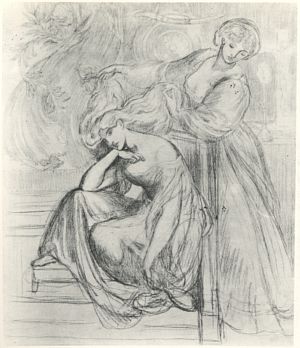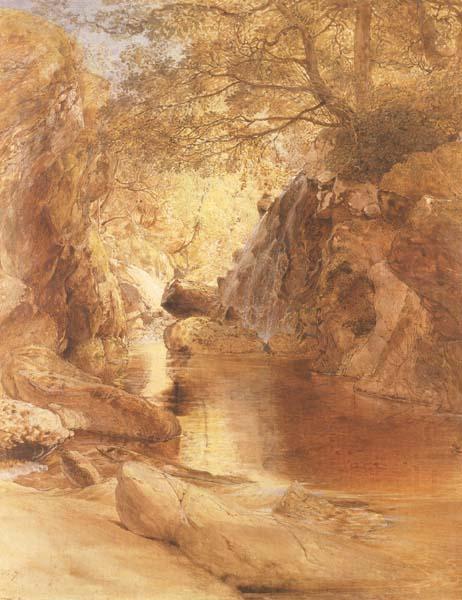Saturday, February 2, 2013
Romantic Traditions in Britain: Samuel Palmer, J.M.W. Turner, William Blake, Dante Gabriel Rossetti
The Artist’s Vision: Romantic Traditions in Britain, was on view a the National Gallery of Art, Washington,from November 19 through March 18, 2007. The exhibition featured approximately 70 works from the late 18th century through the early 20th century including artworks by Samuel Palmer, J.M.W. Turner, William Blake, and more.
Created against a backdrop of political and social upheaval, British romantic art exemplified a revival of interest in medieval art and subject matter, a rebellion against conventional ideas and academic styles, and an assertion of the importance of emotion over intellect.
Dante Gabriel Rossetti's drawing of Desdemona's Death Song (c. 1879), the most complete version of a project that haunted the artist for years and a recent acquisition for the Gallery, was exhibited here for the first time. This drawing was hung beside
an earlier version of the same subject, providing visitors with a rare opportunity to compare the two works and to trace the evolution of Rossetti's ideas. The moment depicted is one from the end of Shakespeare's Othello: Desdemona singing her "willow song" of unrequited love moments before Othello murders her in a fit of jealous rage.
The romantic artist’s passionate identification with nature and his belief in its ability to inspire deep emotion led to new developments in art and literature. The first section of this exhibition traces the evolution of the romantic landscape from 18th-century ideas about the sublime and picturesque. Highlights include two watercolors by Paul Sandby,
John Constable's drawing A Great Oak Tree (c. 1801),
and a panoramic view of a mountainous landscape by Alexander Cozens.
The pastoral landscapes of Samuel Palmer and the Ancients, an artistic brotherhood united in their admiration for poet and painter William Blake, form an interesting case study of romantic ideas about nature. The exhibition included
Palmer's visionary watercolor Harvesters (1830),
as well as a rare, hand-colored impression of his etching The Sleeping Shepherd (1857).
With the rediscovery of Palmer in the 1920s, British printmakers F. L. Griggs, Graham Sutherland and others turned to the Ancients for inspiration, drawing romantic traditions into the 20th century with their own landscape etchings.
Many of the greatest British landscapes of the 19th century are watercolors, and a section of the exhibition spotlights the Gallery's rich collection of works in this medium. Emerging techniques in watercolor complemented romantic views of nature and were well suited to capture transient effects of weather and light.
Thomas Girtin, a pioneer in watercolor, was represented by Conway Castle, North Wales (c. 1800).
Among the works by J.M.W. Turner was
Ingleborough from the Terrace of Hornby Castle (c. 1818), generously lent by a private collector, which demonstrates the subtlety complexity of the artist's watercolor techniques.
Samuel Palmer's A Cascade in Shadow (c. 1836), also from a private collector, is a stunning naturalistic view in departure from earlier works, and
John Martin's View on the River Wye, Looking toward Chepstow (1844) provides a splendid example of an exhibition watercolor, a large-format work intended to rival oil painting.
Similar image:
John Martin, The Wye Valley, View from Wyndcliffe looking towards Chepstow 1844,
The romantic fascination with extremes of human behavior found artistic expression in the works of Henry Fuseli and his circle. Described as "shockingly mad" by contemporaries, Fuseli's treatment of supernatural and horrific themes influenced artists ranging from John Hamilton Mortimer to George Cruikshank. Perhaps the most important artist in this group is William Blake, represented by a number of works, including one of his widest known and most admired apocalyptic watercolors,
The Great Red Dragon and the Beast from the Sea (c. 1805).
Romanticism in its purest form peaked before the middle of the 19th century, but many of its major trends lingered for decades in the work of Pre-Raphaelite artists, including Dante Gabriel Rossetti and Edward Burne-Jones. Rossetti was one of the founders of the Pre-Raphaelite Brotherhood, a group of British artists who rejected early 19th-century academic conventions and turned instead to early Italian painting and to nature for inspiration.
Additional images from the exhibit:
The Thames at Battersea
by David Cox, 1824, watercolor and graphite on wove paper,
711/16 x 10?. Collection National Gallery of Art, Washington, DC.
Jane Morris
by Dante Gabriel Rossetti, 1870, pen and iron gall ink with brown wash on laid paper, 6? x 87/16. Collection National Gallery of Art, Washington, DC.
George Fennel Robson (British, 1788-1833), A Loch in Scotland, Watercolor over graphite, 19-1/16 x 30-7/8 inches, National Gallery of Art, Ailsa Mellon Bruce Fund, 1989.37.1.
Sir Edward Coley Burne-Jones (British, 1833-1898), Ariadne, 1863/1864. Watercolor and gouache over graphite, 48-3/4 x 21-1/4 inches. National Gallery of Art, The Armand Hammer Collection, 1989.2.1.
Also see this excellent article.











